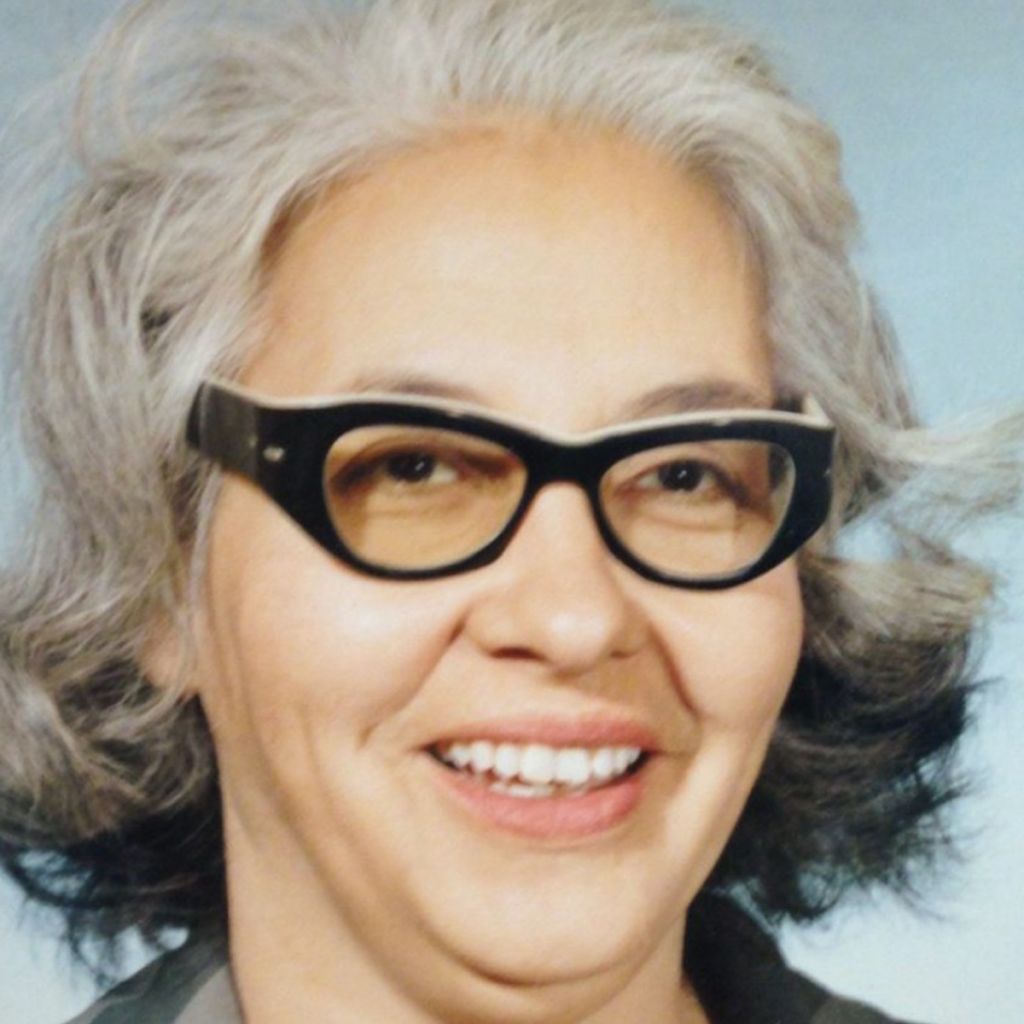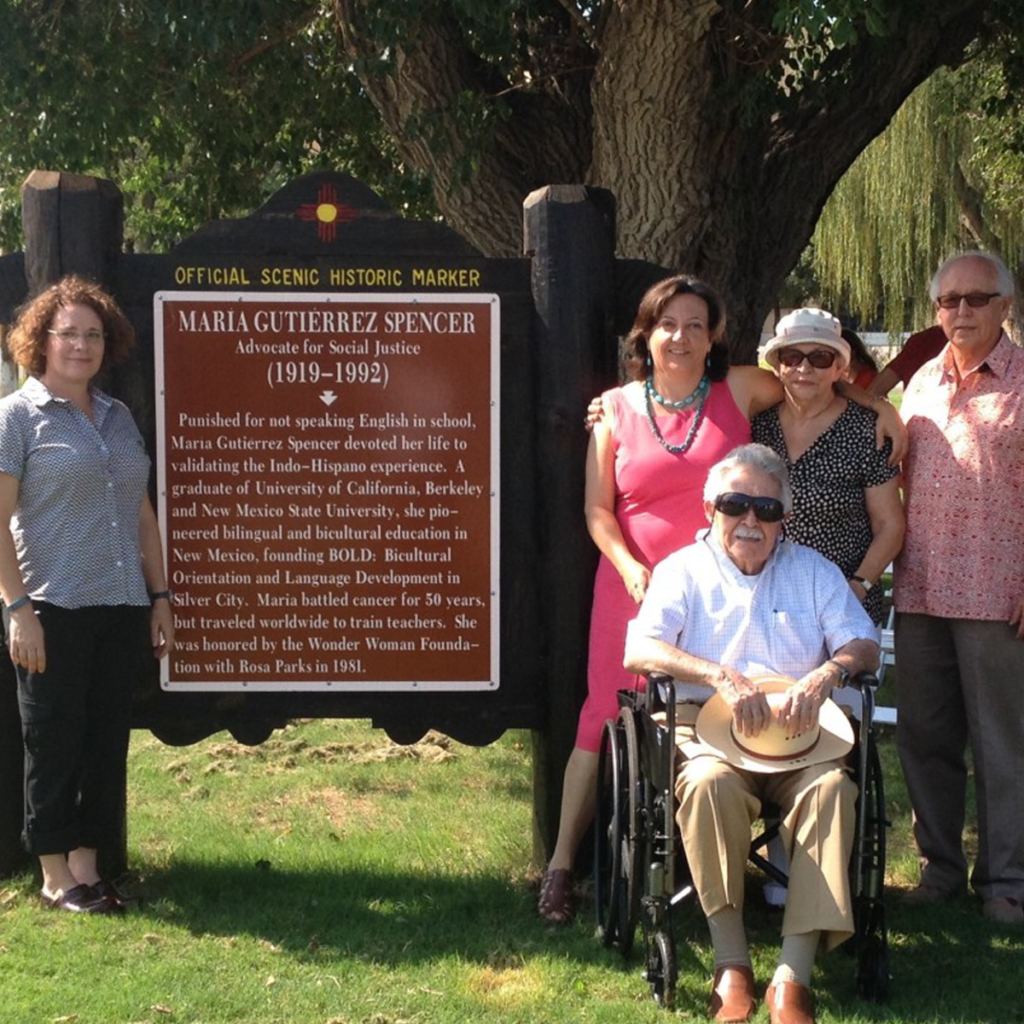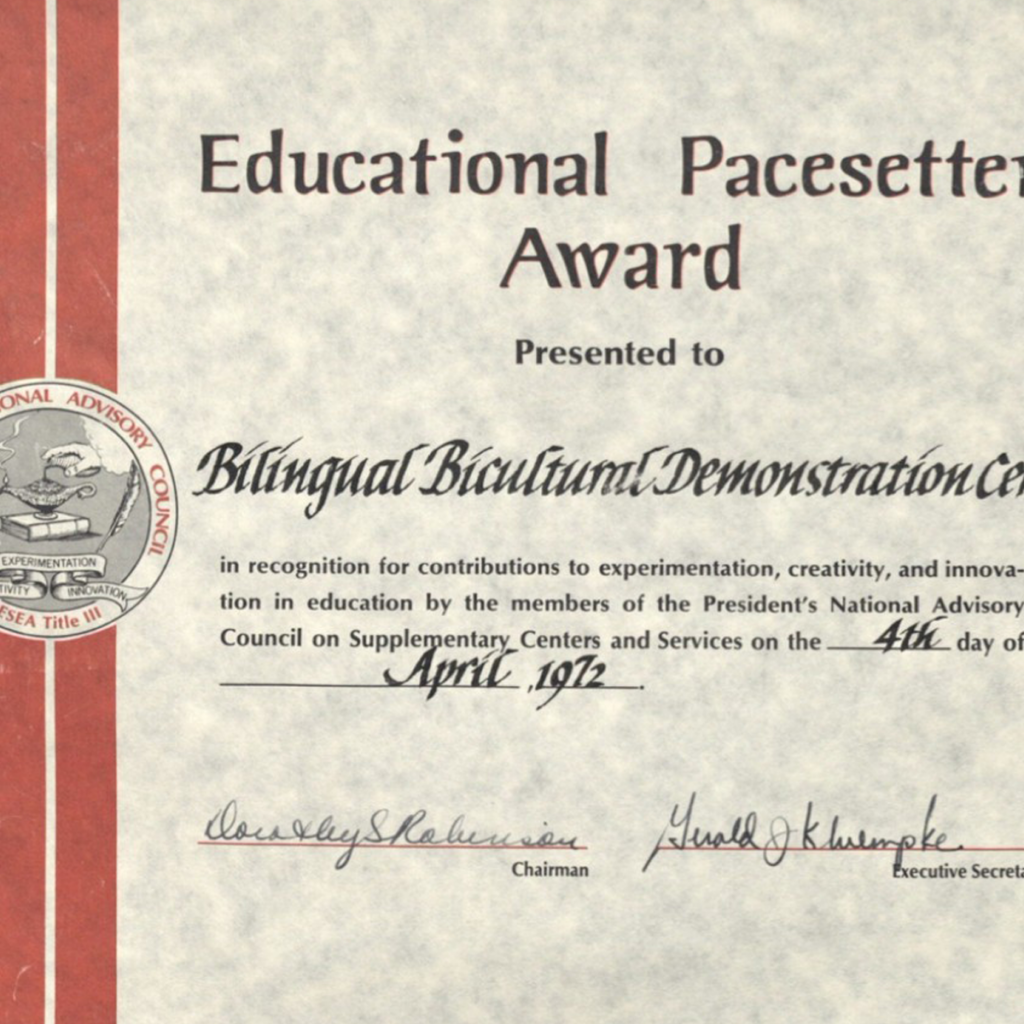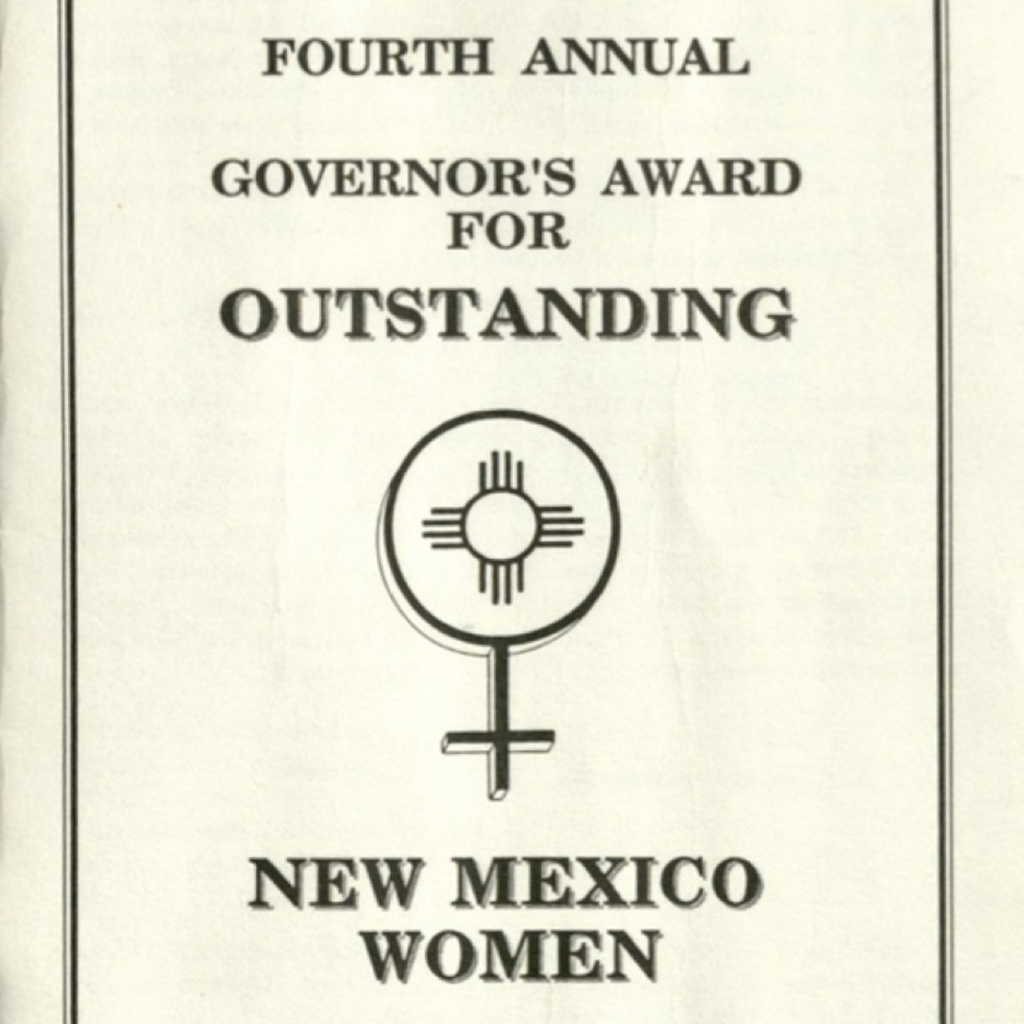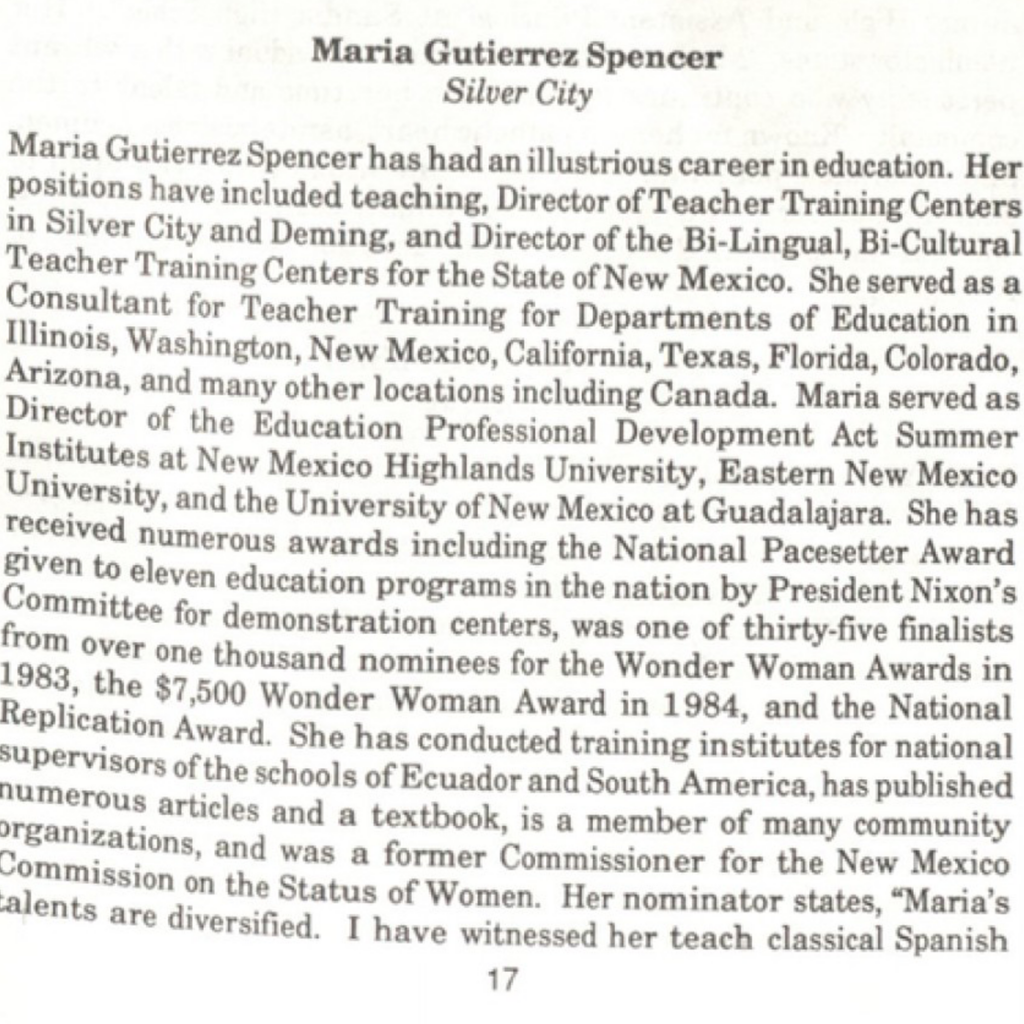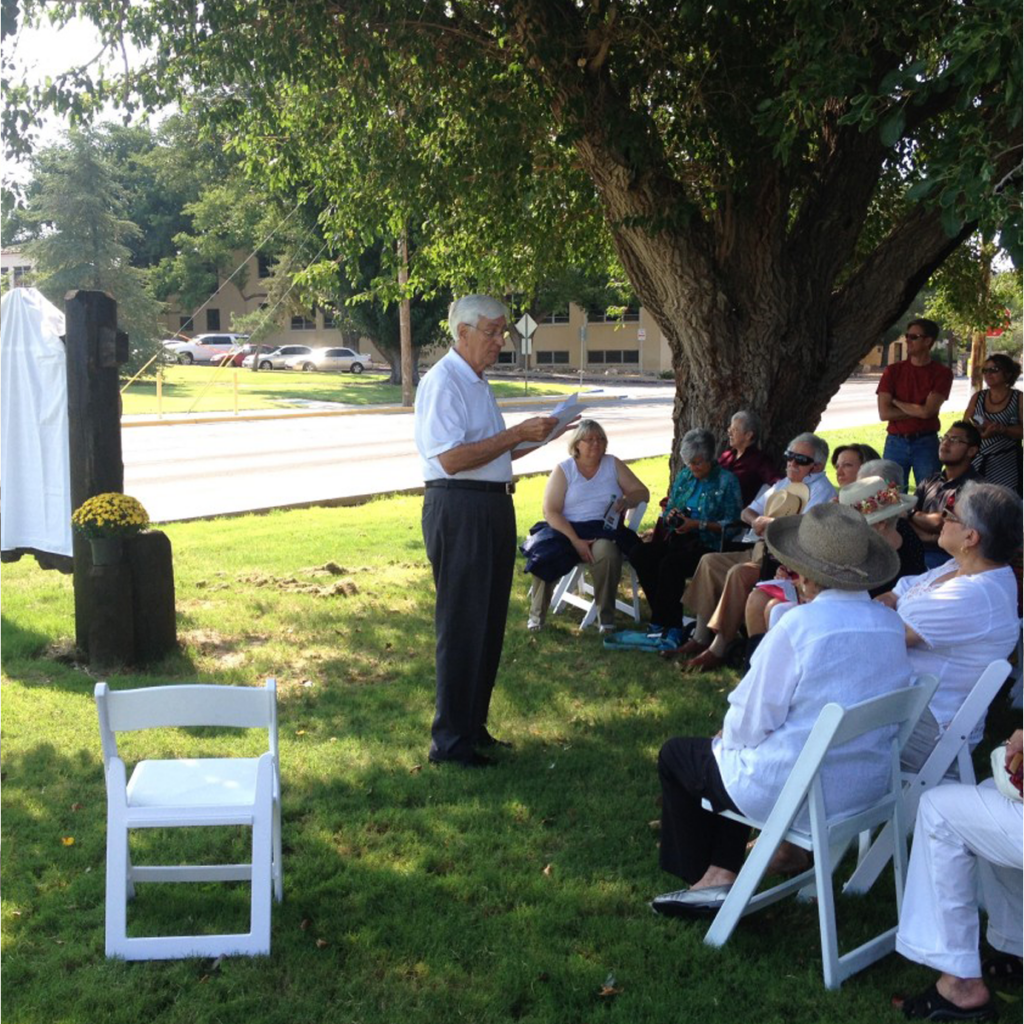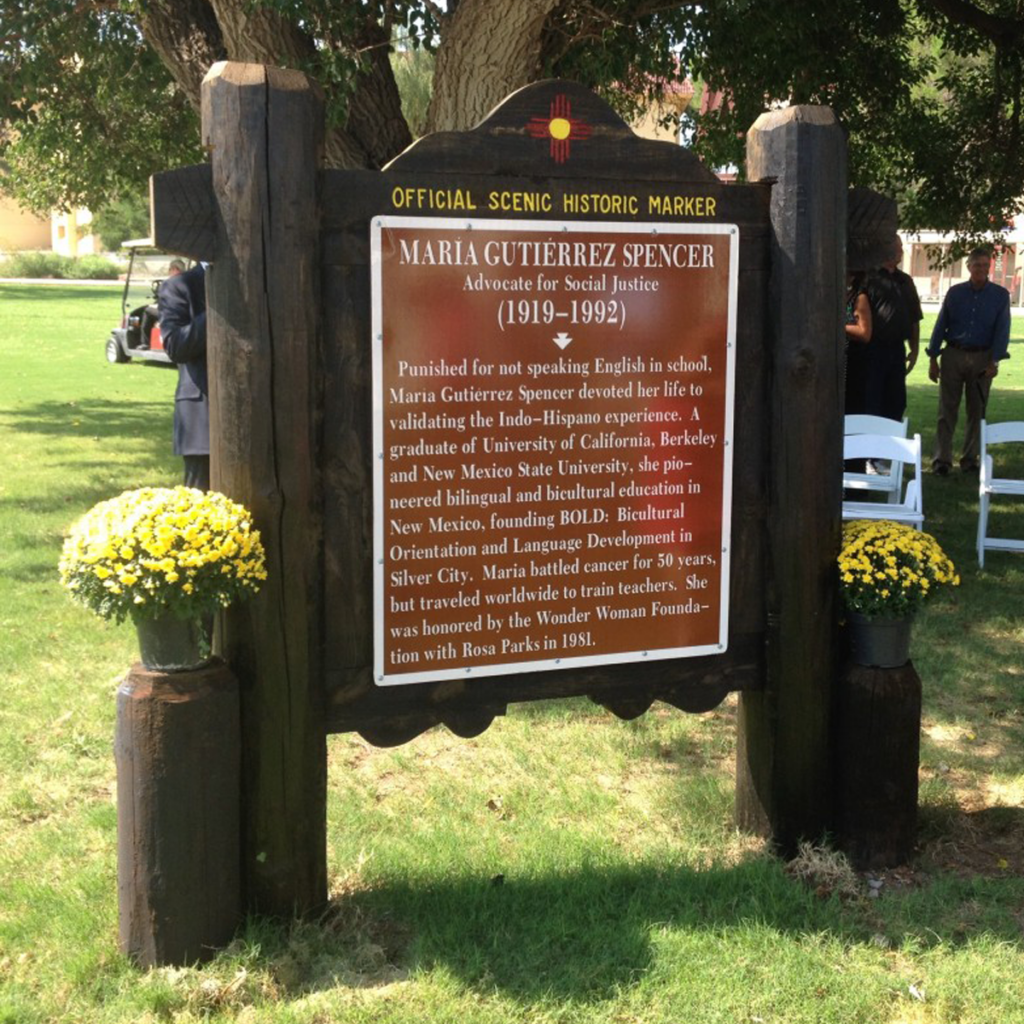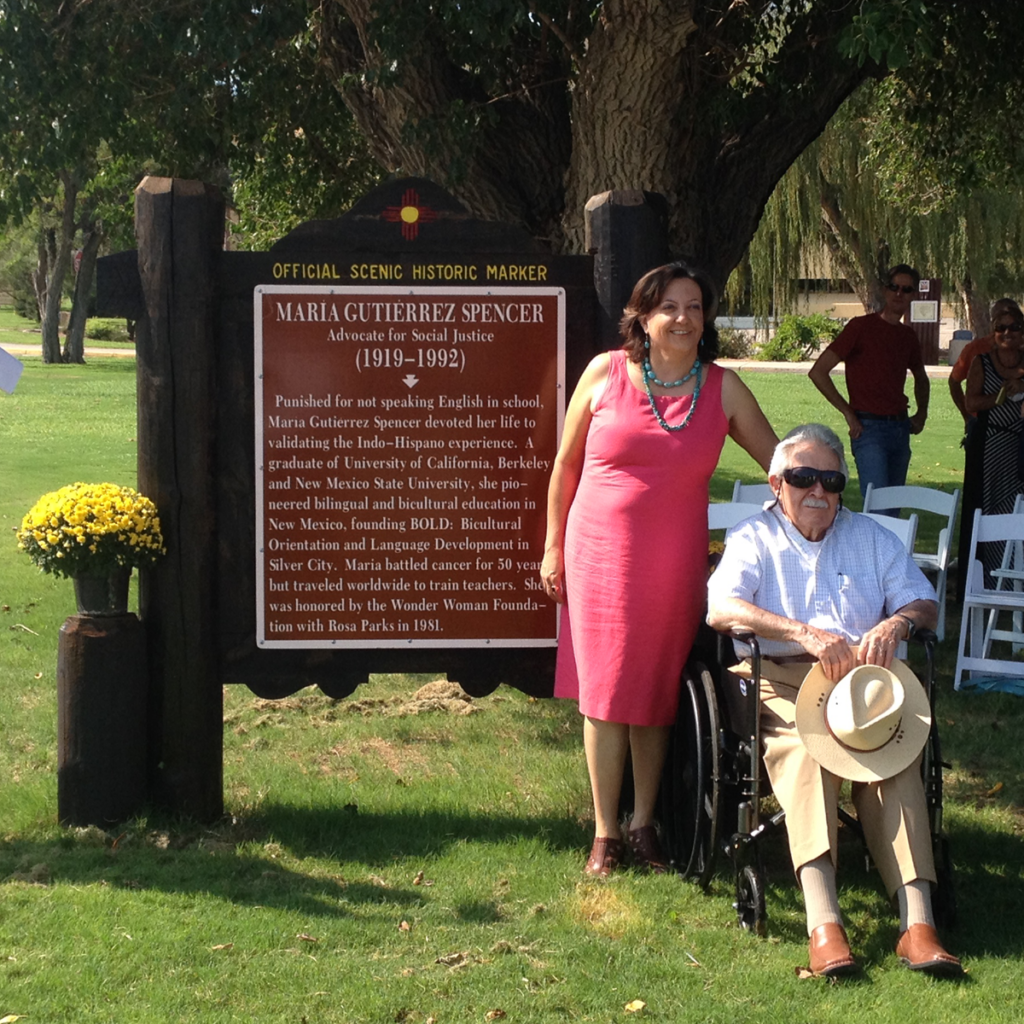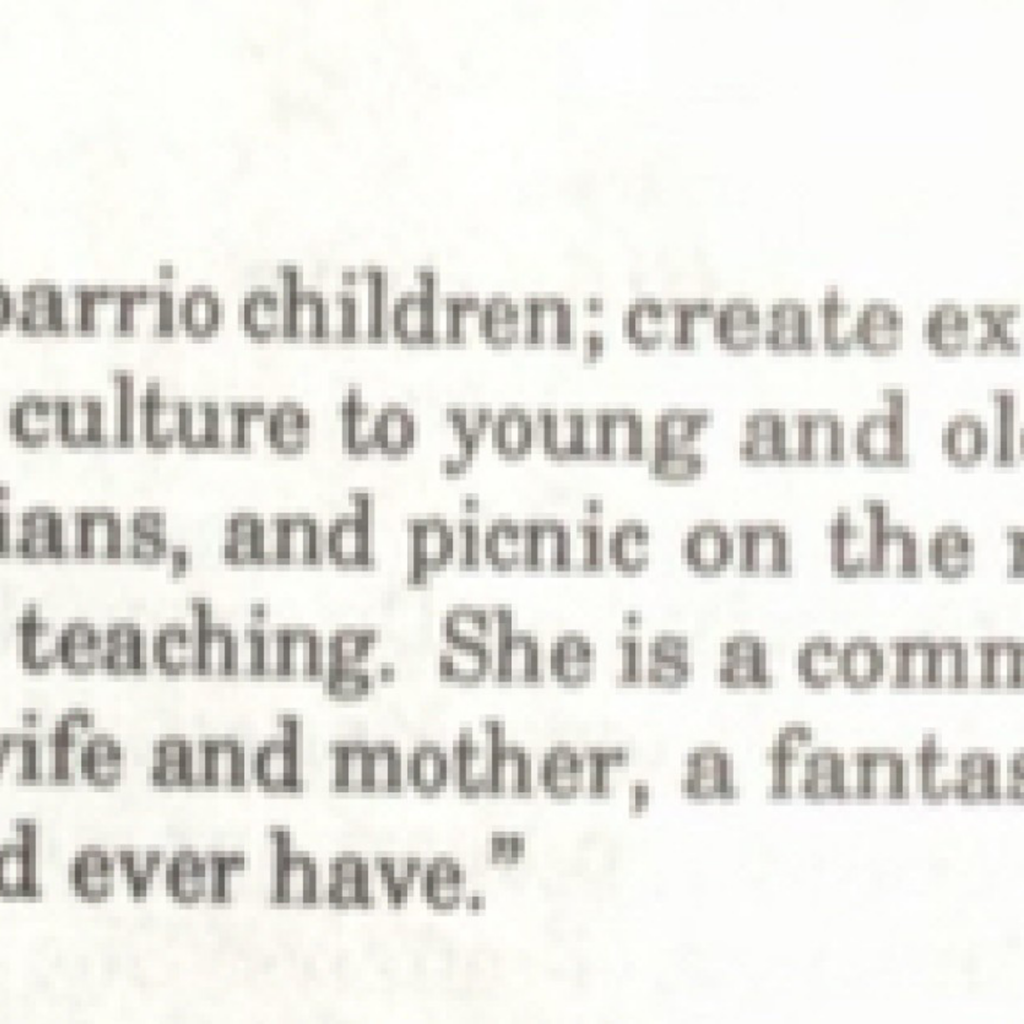Maria Gutierrez Spencer.
Photo Credit: Courtesy of New Mexico Historic Women Marker Program. Courtesy of New Mexico Historic Women Marker Program. Courtesy of New Mexico Historic Women Marker Program.
Maria Gutierrez Spencer
1919 - 1992
Dona Ana County
A bilingual student who excelled in school, she became a lifeline advocate for bilingual education and helped pioneer the field in New Mexico schools and beyond. Her revolutionary work teaching Spanish for heritage speakers became a model for programs throughout the country.
María Gutiérrez Spencer seems to have found her calling at age five on her very first day of school: Maria, who spoke only Spanish, could not follow the English instructions her teacher was giving her, and she was sent to the principal’s office. She would go on to become a lifeline advocate for bilingual education and help pioneer the field in New Mexico schools.
María Gutiérrez Spencer was born on December 17, 1919, in Las Cruces, New Mexico. Her parents were Jesus Borunda Gutiérrez and Aurora Valdéz. She spent her childhood in Las Cruces and excelled at school. As graduation neared, she asked her father, “If I graduate as valedictorian, will you send me to Berkeley?” According to her daughter, Laura Gutiérrez Spencer, María asked this question when her father was reading the paper and she knew he wasn’t paying attention – and he said yes. Though she graduated salutatorian, not valedictorian, from Las Cruces High School in 1933, her father stuck to his word. She went first to Riverside Junior College to become acclimated, then enrolled at Berkeley.
She excelled in her education, majoring in Spanish and Latin American history. She was the first woman to be a Teaching Assistant in both the History and Political Science Departments.
After her graduation in 1941, she worked briefly as a translator in New York, then returned to California and her first teaching assignment, at Riverside Polytechnic High School, a challenging first job. She often took away chains and other weapons from the students, once even removing a knife a girl had concealed in her hairdo. Nonetheless, as summarized by the Las Cruces Sun News in a November 14, 1984 article, she “with patience and empathy, turned their suspicion to trust and eventually mutual affection.”
In her early twenties, she received her first diagnosis of breast cancer. Despite the diagnosis, she battled the disease for some fifty years. After the diagnosis, she returned to Las Cruces to be closer to her family. There, she accepted a position teaching Spanish at her alma mater, Las Cruces High School, a position she held for fifteen years. In her class, she separated non-native speakers from native-speakers, keeping each on separate tracks for two years, then combining the students in the third year. This innovative approach allowed her to work with each group at the level they needed to progress. Her instructors also offered to teach Spanish to other teachers at the school.
Gutiérrez Spencer also added to students’ cultural understanding through extracurricular programs, including instruction in folk-dancing. Her students performed their dances throughout the community. In an article published in the New Mexico School Review, she explained some of the rationale for her work. Her words, written in 1952, are prescient: “The increasingly important role that the United States is playing in international affairs, and the growing cultural, political, and economic ties which bind us to the other countries of the free world make it imperative that the schools teach foreign languages effectively. The schools must not only be ready to produce language experts, but to prepare the general student for world citizenship.”
In 1950, she received her master’s degree from the New Mexico College of Agriculture and Mechanic Arts (now NMSU). During summers when school was out, she led tours in Mexico. She met her husband through the program. When she invited other teachers at the high school to take her tours, they agreed, provided the music teacher, Lewis Spencer, went as well. According to her daughter, the other teachers were hoping to use the opportunity to introduce themselves to this handsome man. She convinced Mr. Spencer to go, but he preferred to sit with her, the tour leader. They were married in July 1955.
When a professorship position in music opened at Western New Mexico University in Silver City in 1963, the couple moved, making their home in a beautiful house at 1665 Montana Street. She took a job as a traveling Spanish teacher. She visited public schools with puppets and put on fun shows to help the students learn Spanish. According to her daughter, Gutiérrez Spencer learned a great deal about the poor treatment Spanish-speaking students were still receiving in schools. IQ tests were given in English only, creating a barrier for students for whom English was not the first language. She also remembered a phone in one school with a sign above it reading, “Spanish may not be spoken on this phone.”
As the government began to focus on bilingual education over immersing native Spanish-speakers into English-only classrooms, federal money became available to fund projects in bilingual education. In 1967, María wrote an application to start her own program and received such a grant. This was the beginning of the BOLD program: Bicultural Orientation and Language Development.
The BOLD program helped Spanish-speaking students increase their education through the teaching of writing, science, and other subjects, all in Spanish, along with ESL, and also to help develop their self-esteem through exposure to leaders in their own culture.
Gutiérrez Spencer set up a classroom at the Sixth Street School in Silver City. She hired and trained her own teachers for the project. She either bought Spanish-language textbooks or hired people to translate English textbooks into Spanish. She gave students non-verbal IQ tests to assess their true ability. Students in the BOLD program were taken out of their other classes and attended only her classes. Half the day was spent doing ESL, the other half was taught in Spanish. When students could, they were integrated back into the mainstream classroom.
Students in the BOLD program were successful, and the program itself began to receive attention and further funding. It included a federally-funded Bilingual/Bicultural Demonstration Center to train bilingual education teachers, who might spend up to two weeks observing the work of Gutiérrez Spencer and her staff. Her program won the Educational Pacesetter Award from the President’s National Advisory Council on Supplementary Center and Services in April 1972. With other instructors, she traveled around the state to teach other teachers in bilingual education best practices.
Unfortunately, her success and the attention she and her program were receiving made her a target for prejudice and racism. According to the Reportero newsletter, some people in town “accused her of being sent from Mexico by Communists to cause problems.” Her daughter Laura remembers her mother drawing the curtains in their home at night, afraid of being the victim of hostile attack. In April 1973, she was fired for “insubordination” with no explanation given. A volatile meeting of the School Board soon thereafter included a number of mothers of Gutiérrez Spencer’s students standing and pointing at the members of the School Board, shouting, “Shame!”
Working with the state of New Mexico, Gutiérrez Spencer then moved the program, including the teacher training center, to Deming, where she found the school system and community more receptive. This required her to commute each morning from Silver City; she didn’t drive, so she traveled with one of her instructors, John Goehring. Mr. Goehring recalls that Gutiérrez Spencer often used the commute time as a self-instructional opportunity. She wrote new words she wanted to learn on flashcards and drilled Goehring and her daughter Laura, who was enrolled in the Deming school system, until their vocabulary increased.
The program in Deming, no longer known as BOLD, had students at the Martin Elementary School attending a half-hour training in ESL, taught in part by John Goehring, followed by a half-hour training in science, social studies, and other courses, taught in Spanish. Students in all grades, 1-6, attended. Students then returned to their regular classrooms for the remainder of the day.
Her innovative programs included encouragement to teachers to use body language and praise to “create a happy climate for learning and growing.” She even suggested that teachers adapt presentations to the attention span of children who were becoming accustomed to shorter television shows and frequent commercial breaks.
The program also included training for current or potential bilingual educators from around the state, known as the New Mexico Bilingual Teacher Training Center. These teachers spent two days observing the bilingual classrooms in Deming, and a third day teaching in those classrooms themselves. During the third day, their instruction was videotaped and critiqued to help them learn. Gutiérrez Spencer also traveled the state and the country to share her program with other schools and to assess existing bilingual education programs. Gutiérrez Spencer wrote her own bilingual guide for parents as well, Ayudele, published in 1973.
The program in Deming ended in 1978. Though she retired from teaching after that time, Gutiérrez Spencer remained active in the field. The Albuquerque Public School system hired her to evaluate their bilingual education program, where she found instances of fraud–specifically, schools receiving bilingual education funding without having a bilingual program.
María Gutiérrez Spencer was recognized with the Wonder Woman Award in 1984, the same year as Clara Hale and Rosa Parks. As described in the 1984 Sun News article:
“The Wonder Woman Foundation that is honoring Mrs. Spencer today was initiated as a non-profit fund in 1981 to highlight the 40th anniversary of Wonder Woman, the comic book heroine created by William Moulton Marston. Purpose of the fund was to honor contemporary ‘wonder women’ – women over age 40 whose patterns of personal growth have led them toward achievements based on their principles and humanitarian ideals.”
Among her numerous other awards are the Western States Expo Award for Creativity in Education (1973), New Mexico Bilingual Association Hall of Fame Award (1978), the New Mexico Public Service Award (1988), the NM Commission on the Status of Women’s “Outstanding New Mexico Women,” and the Governor’s Award for Outstanding New Mexican Women (1989).
In an interview, John Goehring remembers Gutiérrez Spencer as a “fearless” woman with a great sense of humor. “She tried to honor children and to develop their ability to be bilingual, and to be proud of being bilingual.” Her daughter remembers her as audacious, brilliant, loving, and fun–a person with a “thirst for justice. Gutiérrez Spencer herself often used an analogy to explain why she felt bilingual education was so important: “In the past, schools may be compared to a gardener who buys an expensive rosebush, cuts the roots, lavishes care, water, insect-repellent, and plant food. In the end he has a stump. And so the schools in their efforts to make a yellow rose out of a red rose, cut the roots and produce stumps.”
María Gutiérrez Spencer died from breast cancer in 1992 in Silver City, age 72, fifty years after her initial cancer diagnosis. She was cremated, and her ashes were scattered at the foot of the Organ Mountains in Las Cruces.
Sources:
Papers of María Gutiérrez Spencer, UNM Center for Southwest Research, University of New Mexico, Albuquerque, NM.
Laura Gutiérrez Spencer. Interview. Conducted by David Pike, Las Cruces, May 12, 2014.
John Goehring. Interview. Conducted by David Pike, May 21, 2014.
“Former Las Crucen a Wonder Woman Award Recipient.” Las Cruces Sun News, November 14, 1984.
Gutiérrez de Prieto, María. “The Community Can Be Sold on Spanish.” New Mexico School Review, April 1, 1952.
Gutiérrez Spencer, application form for “Directory of Significant 20th Century American Minority Women” in the papers of María Gutiérrez Spencer, Center for Southwest Research, UNM.
Directions:
Maria Gutierrez Spencer
Dona Ana County
Activist | Community leader | Educator |
Statehood (1912 - present) |
Southwest



